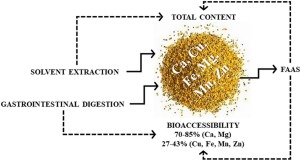Journal of Trace Elements in Medicine and Biology ( IF 3.6 ) Pub Date : 2020-02-28 , DOI: 10.1016/j.jtemb.2020.126479 Pawel Pohl , Anna Dzimitrowicz , Anna Lesniewicz , Maja Welna , Anna Szymczycha-Madeja , Piotr Cyganowski , Piotr Jamroz

|
Background and aim
Bee pollen is recognized to be a source of different nutrients, including minerals. As a food supplement, its quality and safety due to concentrations of essential macro- and microelements, and harmful trace elements has to be verified. Fast and simple element analysis of bee-collected pollen can be regarded as an important part of its quality assurance and control. The present study aimed to develop a new method for determination of selected elements (Ca, Cu, Fe, Mg, Mn, Zn) of bee pollen based on solvent extraction and completely avoiding a high temperature treatment with concentrated reagents. In addition, in vitro gastrointestinal digestion was used to assess bioavailability of elements from this food supplement.
Methods
Bee pollen samples were dried and pulverized. Total concentrations of Ca, Cu, Fe, Mg, Mn, and Zn was obtained by wet digestion (WD) in concentrated HNO3 or alternatively by solvent extraction (SE) with diluted solutions of HNO3, followed by determination of elements by flame atomic absorption spectrometry (FAAS). Gastrointestinal digestion was mimicked using simulated solutions of gastric and intestinal juices followed by determination of Ca, Cu, Fe, Mg, Mn and Zn concentration sin the bioaccessible fraction by FAAS.
Results
A new simple and fast method for determination of total concentrations of Ca, Cu, Fe, Mg, Mn, and Zn in bee pollen was developed and validated. The method combined room temperature, two-hour SE with 0.5 mol L-1 HNO3 with FAAS measurements versus simple standard solutions. It provided precision within 1-5% and trueness better than 8%, and was shown to be suitable for fast analysis of different polyfloral bee pollens. In vitro gastrointestinal digestion revealed that elements were well (70-85% for Ca, Mg) and fairly (27-43% for Cu, Fe, Mn, and Zn) bioaccessible from bee pollen. By pouring with water and swelling overnight, bioaccessibility of studied elements from such prepared bee pollen was increased on average by less than 15% (Mn), 20% (Ca, Cu, Fe, Zn) or even 30% (Mn).
Conclusions
Avoiding long-lasting, high-temperature wet digestion with concentrated reagents, the proposed sample treatment along with FAAS provided precise and true results of total concentrations of Ca, Cu, Fe, Mg, Mn, and Zn in bee pollen. The method was simple and fast, and enabled to analyze a higher number of samples. Simulated gastrointestinal digestion of bee pollen have shown for the first time that Ca and Mg are the most bioaccessible. Bioaccessibility of Cu, Fe, Mg, and Zn from bee pollen are close to or lower than 40%.
中文翻译:

室温溶剂萃取,用于通过FAAS简便快速地测定蜂花粉中Ca,Cu,Fe,Mg,Mn和Zn的总浓度,并使用体外胃肠消化法评估这些元素的生物可及部分
背景和目标
蜂花粉被认为是多种营养素的来源,包括矿物质。作为食品补充剂,由于必需的大量微量元素和微量元素以及有害微量元素的浓度,其质量和安全性必须得到验证。蜜蜂采集的花粉的快速,简单的元素分析可以被视为其质量保证和控制的重要组成部分。本研究旨在开发一种新方法,用于基于溶剂萃取的蜂花粉中选定元素(Ca,Cu,Fe,Mg,Mn,Zn)的测定,并且完全避免了使用浓缩试剂进行的高温处理。此外,体外胃肠道消化用于评估该食品补充剂中元素的生物利用度。
方法
将蜂花粉样品干燥并粉碎。Ca,Cu,Fe,Mg,Mn和Zn的总浓度可通过在浓HNO 3中进行湿消化(WD)或通过用HNO 3稀释液进行溶剂萃取(SE)来获得,然后通过火焰原子测定元素吸收光谱法(FAAS)。使用胃液和肠液的模拟溶液模拟胃肠道消化,然后通过FAAS测定生物可及部分中的Ca,Cu,Fe,Mg,Mn和Zn浓度。
结果
建立并验证了一种测定蜜蜂花粉中钙,铜,铁,镁,锰和锌总浓度的简便快捷的新方法。该方法将室温,两小时SE与0.5 mol L -1 HNO 3结合FAAS测量与简单的标准溶液相结合。它提供的精确度在1-5%之内,真实性优于8%,并被证明适用于快速分析不同的多花蜂花粉。体外胃肠道消化显示,蜂花粉中的元素可以很好地利用(钙,镁占70-85%),并且相当容易(铜,铁,锰和锌占27-43%)。通过倒水和溶胀过夜,来自这样制备的蜂花粉的研究元素的生物利用度平均提高不到15%(Mn),20%(Ca,Cu,Fe,Zn)或什至30%(Mn)。
结论
为了避免长时间使用浓缩试剂进行高温湿法消化,建议的样品处理方法与FAAS一起提供了蜂花粉中Ca,Cu,Fe,Mg,Mn和Zn的总浓度的精确而真实的结果。该方法简便快捷,可以分析更多样品。蜂花粉的胃肠道模拟消化首次表明,钙和镁是最易生物利用的。蜂花粉中铜,铁,镁和锌的生物可及性接近或低于40%。











































 京公网安备 11010802027423号
京公网安备 11010802027423号